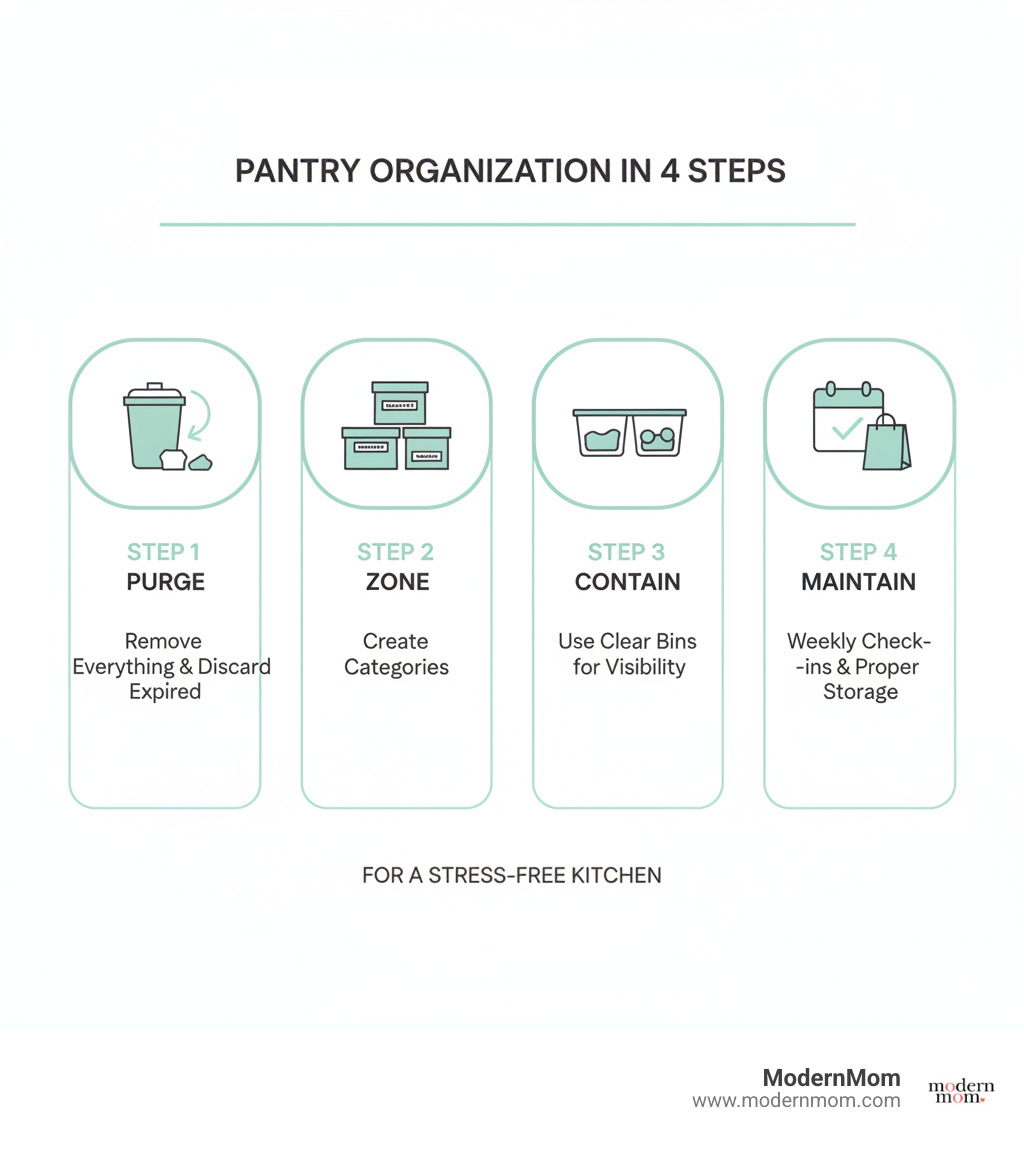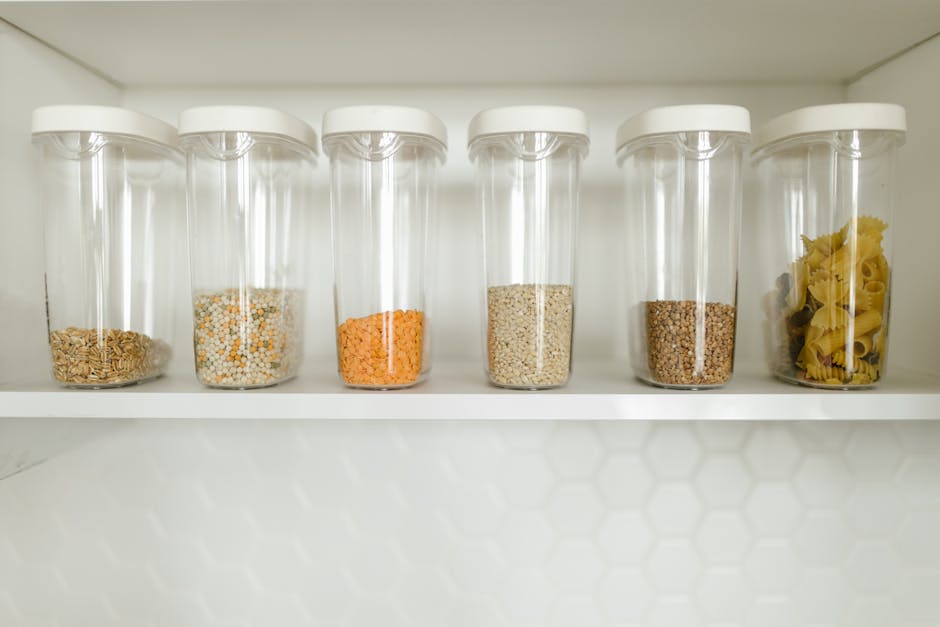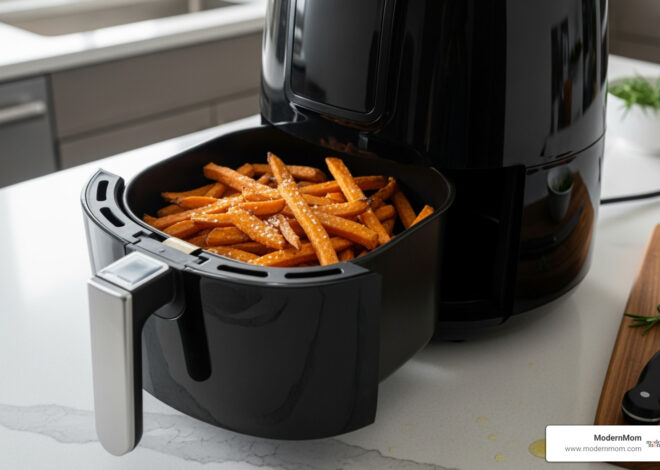From Chaos to Calm: Why Every Busy Mom Needs a Pantry Plan
Pantry organization tips can transform one of the most frustrating spaces in your home into a stress-free zone that actually works for your family. Here’s what you need to know:
Quick Pantry Organization Steps:
- Purge – Remove everything, toss expired items, donate what you don’t use
- Zone – Group similar items together (breakfast, snacks, baking, dinner helpers)
- Contain – Use clear bins, baskets, and containers for visibility
- Label – Mark everything so your family knows where things belong
- Maintain – Do weekly check-ins and put groceries away correctly
You know the feeling: trying to make dinner after a long day, you can’t find the pasta you know you bought. Or you find three half-empty boxes of cereal while the kids are asking for breakfast.
A disorganized pantry isn’t just annoying—it’s expensive. The average American household wastes about $1,500 per year on uneaten food. That’s money for family activities, savings, or breathing room in your budget.
When you can’t see what you have, you buy duplicates. Buried items expire. When meal prep feels like a scavenger hunt, cooking becomes another stressful task instead of a nourishing one.
The good news? You don’t need a Pinterest-perfect pantry or expensive systems. With a few simple strategies, you can create a pantry that saves you time, money, and mental energy—giving you more of what matters most.

The Great Pantry Purge: Your First Step to a Fresh Start
The truth is, you can’t organize clutter. Before buying any containers, you need to see what you’re working with.
The first step is simple but powerful: take everything out. Yes, everything. It might feel overwhelming when you see a mountain of food on your counter, but this is where real change begins.
Think of it as a pantry reset. With bare shelves, you can see what you have, what’s taking up space, and what’s been hiding. This essential purge is the foundation for pantry organization tips that stick, helping you avoid just shuffling clutter around.
Assess and Declutter
With everything spread out, it’s time to make some decisions. Go through each item and ask the tough questions.
Start with expiration dates. Toss anything that’s past its prime—no exceptions. That can of beans from 2019? Gone. The spices that lost their smell? Time to say goodbye.
Next, be honest about what your family will actually use. That bag of ancient grains nobody will eat? If an item has been sitting untouched for months, it’s time for it to go.
Watch for duplicates too. A chaotic pantry leads to buying what you already own. You might find three bottles of vanilla extract or five boxes of pasta, all because they were buried.
While sorting, keep an eye out for pantry pests like ants or moths. If you spot any, dispose of affected items immediately and clean the area thoroughly.
Create three piles: keep, toss, and donate. For unopened, unexpired items your family won’t use, bag them up for your local food bank. You’ll free up precious space for what you actually need. For more budget-friendly organizing ideas, check out our guide on Pantry Organization on a Budget.
Clean and Prep
With your pantry empty, it’s time for a deep clean. Wipe down every shelf, wall, and corner to get rid of crumbs, dust, and sticky spots.
This is also the perfect time to add shelf liners. They protect shelves, make cleanups easier, and add a fresh, polished look.
Don’t skip this step: measure your space. Note the width, depth, and height of each shelf. These measurements will save you money and frustration when buying containers, ensuring your new organizers fit perfectly.
Starting with a clean slate and exact dimensions ensures every item has a proper home. This prep work is key to long-lasting organization.

Creating Your System: The Magic of Zones and Labels
With a clean, empty pantry, you can build a system that works for your family. The secret is zones and labels. These tools turn a random collection of food into an organized space where everything has a home.
Think of the mental energy spent tracking down ingredients or answering “Where’s the peanut butter?” again. Zones and labels reduce that load. When everything is clearly marked, your family can find things and put them back correctly.
This isn’t about a magazine-worthy pantry. It’s about building a family-friendly system that smooths your daily routine and keeps chaos at bay.
Find Your Zones
Zoning means grouping similar items so you’re not hunting for ingredients. Need pasta? Go to the Dinner Helpers zone. Kids want a snack? They head to the Healthy Snacks area. It’s that simple.
Start by thinking about how your family uses the pantry. A Breakfast Station with cereal, oatmeal, and pancake mix makes mornings easier. Your Baking Supplies zone keeps flour, sugar, and chocolate chips together. Group pasta, rice, and canned sauces as Dinner Helpers for quick meal prep.
Create a Kid-Friendly Access zone on lower shelves for snacks and lunch items. This saves you interruptions and helps kids feel more capable.
Set aside a Backstock Area on higher shelves for bulk purchases and backup items. This keeps your main zones uncluttered. For a deeper dive into creating effective zones, check out our guide on Pantry Organized by Zones.
The beauty of zones is their flexibility. Your pantry should reflect how your family eats.
The Power of a Good Label
Once your zones are set, labels become your best friend. They’re the difference between a system that lasts and one that falls apart.
Labels provide clarity for everyone. No more guessing what’s in a container or finding crackers in the cereal bin. When everything is marked, the whole family can maintain the system easily.
Labels also make grocery shopping and restocking effortless. A quick scan shows what’s low, and groceries have an obvious home. This prevents the “I’ll just set it here for now” habit that leads to disorganization.
You don’t need fancy equipment. Handwritten labels on masking tape work perfectly. Chalkboard labels are great for items that change frequently. For a polished look, use a basic label maker.
Whatever style you choose, include the expiration date on labels for decanted items. Write it on a small piece of tape on the container’s bottom. This simple habit helps prevent food waste. For more comprehensive strategies, our Kitchen Pantry Organization guide has you covered.
The best pantry organization tips are the ones you’ll use. Labels are a small detail, but they’re what keep your system running smoothly long-term.

Smart Storage Solutions: Your Ultimate Pantry Organization Tips
You’ve purged, cleaned, and zoned. Now for the fun part: choosing storage solutions to make your pantry functional and beautiful.
The secret to a pantry that works is visibility and accessibility. Seeing what you have prevents buying duplicates, and easy reach makes meal prep effortless. A designated snack spot for kids means fewer interruptions.
Clear containers are game-changers for effective pantry organization tips. They help you see what you have and when you’re running low, preventing overspending and food waste.
The key is selecting containers that work for your family. A complicated system won’t last. Let’s explore simple solutions that maximize every inch.
Essential Pantry Organization Tips for Small Spaces
Small pantries can be tricky but efficient with smart solutions. The secret is getting creative with every available inch.
Vertical space is your best friend. Use shelf risers to double your storage capacity instead of just stacking items. For spices, add these small acrylic shelves to side walls for a simple, useful storage fix.
Don’t overlook your pantry door—it’s prime real estate. Over-the-door organizers are great for spice packets, snack pouches, or foil. A shoe rack can even hold pasta packages or dried fruits.
Lazy Susans (turntables) are pantry heroes, especially for corners or deep shelves. They bring everything within reach. We love the Home Edit Lazy Susan for snack bars and the iDesign Divided Lazy Susan for oils and vinegars.
Under-shelf baskets clip onto shelves for instant storage for items like bread or foil. A slim rolling cart can add valuable storage for produce or drinks if you have floor or wall space.
For even more clever ideas, our Small Pantry Organization guide has you covered.
Containers That Work for You
The right containers make all the difference. The goal is to keep food fresh, visible, and create a system that’s easy for the whole family to maintain.
Clear airtight containers are the foundation of an organized pantry. We love these clear OXO Pop containers for dry goods like flour, sugar, and cereal. They stack well, keep food fresh, deter pests, and let you see contents at a glance. The ProKeeper Premium 10-Piece Bakers Set is fantastic for frequent bakers.
Woven baskets add warmth and hide items like bags of chips or produce like onions and potatoes. The Water Hyacinth Storage Bins are durable and beautiful, adding a polished look.
For items you want to see, clear stackable bins like the iDesign Linus Pantry Bins are fantastic for corralling snack pouches or granola bars, especially on high shelves.
Canned goods get lost easily. A Home Edit Three Tier Shelf lets you see all your cans at once, making inventory easy and ensuring you use older cans first.
Decanting bulk dry goods into clear containers keeps food fresher, makes pouring easier, and creates a visually calm space. You don’t need to decant everything—focus on bulk items like flour, sugar, rice, and pasta.
For even more container inspiration, check out our Pantry Organization Bins guide.
More Pantry Organization Tips for a Flawless Finish
A few extra touches can transform your pantry from simply organized to genuinely inspiring.
Pull-out drawers are lifesavers for deep pantries, eliminating the “black hole” where items expire. We love adding these pretty under-the-shelf drawers to shelves for extra storage with good airflow, perfect for some produce. Our Deep Pantry Organization guide offers more solutions.
Floor space matters too. Use large, sturdy baskets on the floor for bulk items like paper towels or large snack bags. This keeps them contained and frees up shelf space.
Add personality to your pantry. A functional space can also be beautiful. Consider peel-and-stick wallpaper, a fresh coat of paint, or a small piece of art. When your pantry feels inviting, you’re more motivated to maintain it. Explore our Pantry Makeover ideas for inspiration.

Keeping the Order: How to Maintain Your Tidy Pantry
You’ve purged, zoned, and labeled, and your pantry looks amazing. The real victory isn’t creating the system, but maintaining it.
The good news? Maintaining an organized pantry is easier than the initial overhaul. With simple habits and family teamwork, your pantry can stay calm. It will continue to save you time, reduce food waste, and make meal prep manageable.
Involve the Family. Clear zones and labels make it easy for everyone to help. When everyone knows where things belong, there’s no excuse for misplaced items. Encourage kids and your partner to put things back in their proper spots. Make it a team effort.
The Weekly Reset is your secret weapon. Set aside 5-10 minutes each week for a quick pantry check-in. Tidy up, wipe up spills, and make sure everything is in its zone. This small habit prevents major messes.
Put groceries away correctly as soon as you get home. When you buy a new item, place it behind the existing one. This “first-in, first-out” approach cuts down on food waste and saves money.
For items you tend to overbuy, try the one-in, one-out rule. Before adding a new bag of flour, use up or toss the old one. This prevents backstock from piling up.
Finally, plan for a deeper clean every few months. Pull out bins, wipe them down, check expiration dates, and reassess if your zones still work for your family. Your pantry should adapt as your life changes.
By weaving these simple habits into your routine, your pantry will remain the organized, efficient space you worked so hard to create. You’ve got this!

Frequently Asked Questions about Pantry Organization
Here are the answers to the most common concerns we hear from busy moms like you.
Do I have to decant everything into new containers?
Absolutely not! Decanting everything is time-consuming and expensive. Focus on what makes the biggest difference, like bulk dry goods (flour, sugar, rice). They stay fresher and stack beautifully.
For items you use quickly, like crackers or granola bars, keeping them in their original packaging is fine. Just corral them in a clear bin or basket so they’re contained and visible. The goal is function, not perfection.
What’s the best way to organize a deep pantry so things don’t get lost?
Deep pantries can be frustrating. The secret is bringing items from the back to the front without digging.
Pull-out drawers are absolute game-changers for deep shelves, letting you slide everything out. Long, narrow bins that you can pull out work similarly.
Lazy Susans are another brilliant solution for deep corners. A quick spin brings everything within reach. They’re perfect for oils, vinegars, and small jars.
Store your most-used items near the front and keep backstock behind them. When you buy replacements, rotate the older items forward. Our Deep Pantry Organization guide has even more strategies.
How can I get my family to help keep the pantry organized?
Getting the family on board is tricky but doable. The key is making the system so simple that it’s easier to follow than to ignore.
Clear labels are your secret weapon. When every bin is labeled, there’s no guessing game. Even young kids can follow picture labels or color-coded systems.
Create a kid-friendly snack zone at their eye level with items they can grab independently. When kids know where their snacks live and can reach them, they’re more likely to put things back.
Walk your family through the new system and explain why it matters—less food waste means more money for family fun. When they see you consistently using the system, they’ll follow suit.
Make it a quick five-minute family task to tidy up. When everyone pitches in, the pantry stays neat without feeling overwhelming. These pantry organization tips work best when the whole household is invested.
Your Path to a Peaceful Pantry
You’ve done it! With these pantry organization tips, you’ve built a system that will make your daily life easier.
Think about what this means: No more digging through cluttered shelves, buying duplicates, or throwing away expired food and wasted money.
Your organized pantry is working for you. You’re saving money by avoiding duplicates. You’re reducing food waste, which is good for your budget and the planet. You’re saving precious time that can be spent on what matters most, like playing with your kids or enjoying a quiet cup of coffee.
Perhaps the biggest benefit is the mental relief. Opening your pantry to see everything in its place is empowering. That sense of control and calm can ripple out into other areas of your life.
Maintaining this system doesn’t require perfection. Life gets messy. The zones and labels you’ve created make it easy to do a quick five-minute reset when things get off track.
We at ModernMom believe that an organized home supports a more peaceful family life. You’ve taken a meaningful step toward that peace, and we’re cheering you on. If you’re finding that clutter and overwhelm extend beyond the pantry, our resources on autism and too much stuff offer additional support for creating calmer, more manageable spaces.
You’ve absolutely got this, and your family is lucky to have a mom who cares enough to create a home that works better for everyone.





